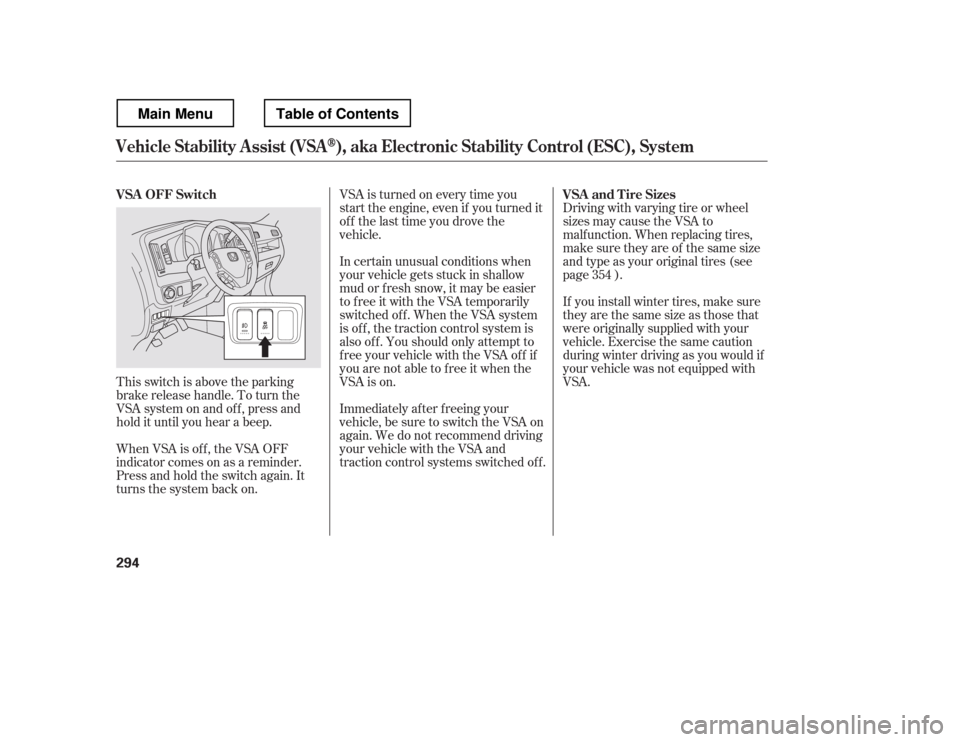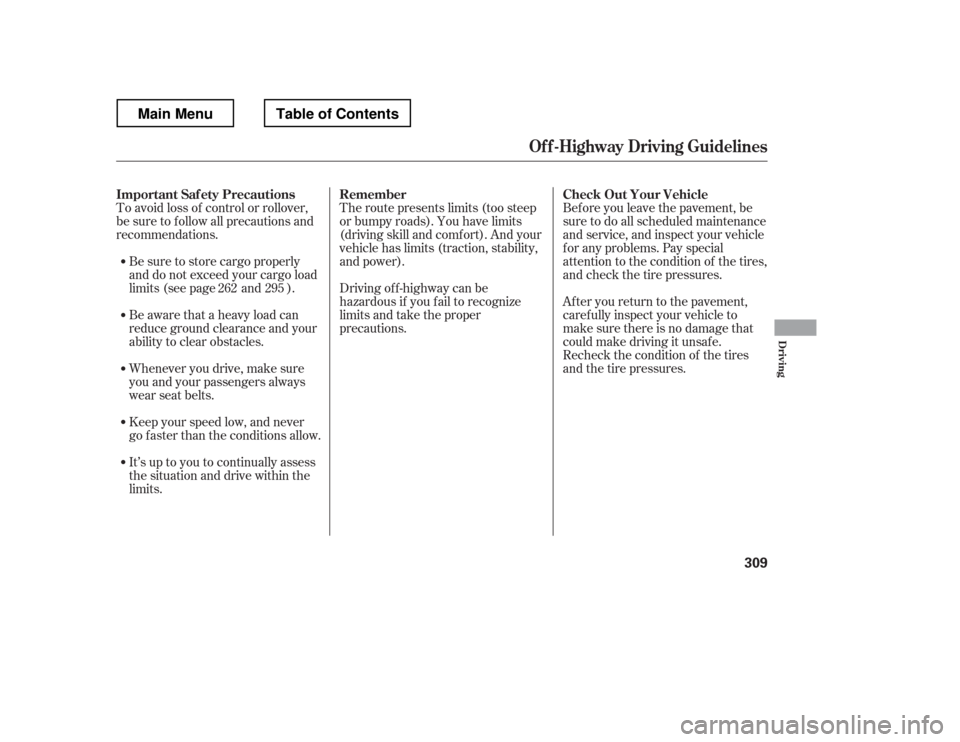Page 300 of 429
When VSA is off, the VSA OFF
indicator comes on as a reminder.
When VSA activates, you will see the
VSA system indicator blink.
If this indicator comes on while
driving, pull to the side of the road
when it is saf e, and turn of f the
engine. Reset the system by
restarting the engine. If the VSA
system indicator stays on or comes
back on while driving, have the VSA
system inspected by your dealer.The main f unction of the
VSA system is generally known as
Electronic Stability Control (ESC).
The system also includes a traction
control f unction. If the low tire pressure/TPMS
indicator comes on, see page .
Or, if the multi-inf ormation display
shows a ‘‘CHECK TPMS
SYSTEM
Page 301 of 429

Driving with varying tire or wheel
sizes may cause the VSA to
malf unction. When replacing tires,
makesuretheyareof thesamesize
and type as your original tires (see
page ).
If you install winter tires, make sure
they are the same size as those that
were originally supplied with your
vehicle. Exercise the same caution
during winter driving as you would if
your vehicle was not equipped with
VSA.
VSA is turned on every time you
start the engine, even if you turned it
off the last time you drove the
vehicle.
This switch is above the parking
brake release handle. To turn the
VSA system on and of f , press and
hold it until you hear a beep.
When VSA is off, the VSA OFF
indicator comes on as a reminder.
Press and hold the switch again. It
turns the system back on. In certain unusual conditions when
your vehicle gets stuck in shallow
mud or f resh snow, it may be easier
to free it with the VSA temporarily
switched of f . When the VSA system
is of f , the traction control system is
alsooff.Youshouldonlyattemptto
f ree your vehicle with the VSA of f if
you are not able to f ree it when the
VSA is on.
Immediately af ter f reeing your
vehicle, be sure to switch the VSA on
again. We do not recommend driving
your vehicle with the VSA and
traction control systems switched off.
354
VSA OFF Switch
VSA and Tire Sizes
Vehicle St abilit y A ssist (VSA), aka Electronic Stability Control (ESC), System
294
Main MenuTable of Contents
Page 303 of 429

�µ�µ
�µ Thebestwaytoconfirmthatall
loads are within limits is to check
them at a public scale (see page
).
To help ensure a saf e drive to a scale,
or if you cannot get to a public scale,
we recommend that you estimate
your total trailer weight and tongue
load as described.
Add the weight of your trailer (as
quoted by the manuf acturer) with
everything in or on the trailer. Then
check the tables on page to
make sure you do not exceed the
limit f or your conditions.
The maximum
allowable weight of the vehicle, all
occupants, all accessories, all cargo,
and the tongue load is 6,050 lbs
(2,745 kg).
The maximum
allowable weight on the vehicle axles
is 3,105 lbs (1,410 kg) on the f ront
axle, and 3,245 lbs (1,475 kg) on the
rear axle.
The maximum
allowable weight of the f ully loaded
vehicle and trailer is 10,088 lbs
(4,575 kg) with the proper hitch.
The GCWR must be reduced 2
percent f or every 1,000 f eet (305
meters) of elevation.
The weight that the tongue of a f ully-
loaded trailer puts on the hitch
should f ollow the recommended load
guidelines (see page ). Too
much tongue load reduces f ront-tire
traction and steering control. Too
little tongue load can make the
trailer unstable and cause it to sway.
297 295
297
Towing Weight Limits
Estimating Loads
Gross Vehicle Weight Rating
(GVWR)
Gross Axle Weight Rating
(GA WR)
Gross Combined Weight Rating
(GCWR)
To Estimate the Total Trailer Weight
Tongue Load
296
Main MenuTable of Contents
Page 316 of 429

Before you leave the pavement, be
sure to do all scheduled maintenance
and service, and inspect your vehicle
f or any problems. Pay special
attention to the condition of the tires,
and check the tire pressures.
After you return to the pavement,
caref ully inspect your vehicle to
make sure there is no damage that
could make driving it unsaf e.
Recheck the condition of the tires
and the tire pressures.
The route presents limits (too steep
or bumpy roads). You have limits
(driving skill and comf ort). And your
vehicle has limits (traction, stability,
and power).
Driving of f -highway can be
hazardous if you f ail to recognize
limits and take the proper
precautions.
To avoid loss of control or rollover,
be sure to f ollow all precautions and
recommendations.
Be sure to store cargo properly
and do not exceed your cargo load
limits (see page and ).
Be aware that a heavy load can
reduce ground clearance and your
ability to clear obstacles.
Whenever you drive, make sure
you and your passengers always
wear seat belts.
Keep your speed low, and never
go faster than the conditions allow.
It
Page 318 of 429
The banks and surf ace under the
water provide good traction. The
water may hide hazards such as
rocks, holes, or mud.
Bef ore driving through water, stop,
get out if necessary, and make sure
that:
If you decide it is saf e to drive
through water, choose a suitable
speed, and proceed without shif ting,
changing speeds, stopping, or
shutting of f the engine.
Do not try to cross water at high
speeds, as this may cause severe
damage to the cooling system or
result in loss of control.
After driving through water, test
your brakes. If they got wet, gently
‘‘pump
Page 399 of 429
The tires on your vehicle meet all
U.S. Federal Saf ety Requirements.
All tires are also graded f or
treadwear, traction, and temperature
perf ormance according to
Department of Transportation
(DOT) standards. The f ollowing
explains these gradings.The treadwear grade is a compara-
tive rating based on the wear rate of
the tire when tested under controlled
conditions on a specif ied government
test course. For example, a tire
graded 150 would wear one and one-
half (1 1/2) times as well on the
government course as a tire graded
100. The relative perf ormance of
tires depends upon the actual condi-
tions of their use, however, and may
depart signif icantly f rom the norm
due to variations in driving habits,
service practices and dif f erences in
road characteristics and climate. The traction grades, f rom highest to
lowest, are AA, A, B, and C. Those
grades represent the tire